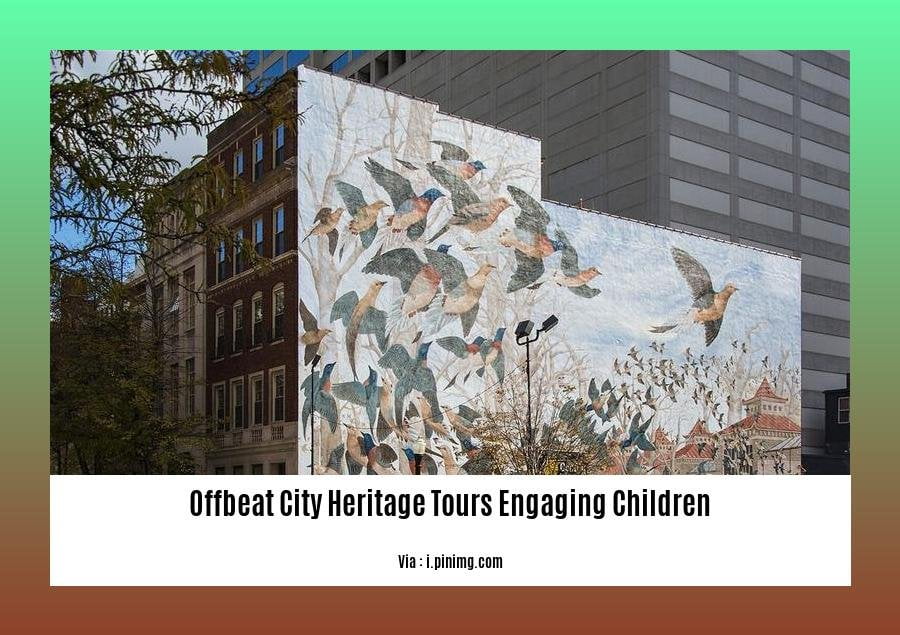**Craft Offbeat City Heritage Tours That Captivate Children**
As a seasoned travel writer and history enthusiast, I’ve embarked on countless urban explorations, unearthing hidden gems that bring cities to life. Recognizing the power of heritage to inspire young minds, I’ve dedicated myself to crafting offbeat city tours designed to ignite a passion for history in children. Join me as we delve into the secrets of the past, transforming urban landscapes into captivating adventures that leave an unforgettable mark.
Key Takeaways:

- The Gateway Arch offers panoramic views of St. Louis and the surrounding area.
- Forest Park provides various activities such as hiking, biking, boating, and picnicking.
- The Saint Louis Zoo exhibits over 12,000 animals from around the world.
- The National Museum of Transportation showcases the history of transportation through various vehicles.
- The City Museum features interactive exhibits like a giant slide, tunnels, and a rooftop playground.
Offbeat City Heritage Tours Engaging Children
In nearly every nook and cranny of cities worldwide, there hides a trove of enthralling tales waiting to be unearthed. By crafting offbeat city heritage tours engaging children, we not only captivate their imaginations but also ignite a lifelong passion for learning.
Fuel Their Curiosity
Offbeat city heritage tours offer a refreshing departure from traditional history lessons. By delving into lesser-known narratives and quirky anecdotes, we spark children’s innate curiosity. Imagine a tour themed around the city’s mischievous street art or the hidden lives of its animal inhabitants.
Embrace Interactivity
Make learning an adventure by incorporating interactive elements into your tours. Scavenger hunts turn city streets into a treasure map, while costumed guides bring historical figures to life. Think hands-on activities like rubbing brass statues for good luck or creating miniature replicas of famous buildings.
Tailor to Their Interests
Consider the unique interests of your young explorers. Would they relish a tour centered around superheroes, pirates, or perhaps even dinosaurs? By tailoring the themes and activities to their passions, we ensure their engagement and make the experience truly memorable.
Keep It Short and Sweet
Remember, children’s attention spans are as fleeting as summer breeze. Keep tours concise, around 60-90 minutes, and pack them with engaging activities to maintain their focus. The shorter the tour, the more they’ll absorb and clamor for more.
Involve the Little Historians
Children are natural storytellers and eager participants. Encourage them to ask questions, share their knowledge, and even lead portions of the tour. By involving them in the storytelling process, we empower them and foster a sense of ownership over their learning.
Examples to Inspire
- Pirate Adventure Tour: Embark on a swashbuckling quest through London’s historic streets, uncovering clues left by legendary buccaneers.
- Superhero City Tour: Explore the real-life locations of iconic superheroes in New York City, from the Daily Bugle to the Avengers Tower.
- Animal Safari Tour: Transform Chicago’s Lincoln Park Zoo into an urban jungle, where children can encounter fascinating creatures from around the globe.
Learn more about city tours highlighting quirky local culture for kids. If you are looking for a unique cultural traditions city tours for families, we have got you covered. Dive into unconventional city culture tours piquing kids’ curiosity.
Keep the tours short and sweet
Hey there, fellow explorers! I’ve spent countless hours uncovering hidden gems in cities worldwide, and one thing I’ve learned is that when it comes to city heritage tours for kids, less is more.
Key Takeaways:
- Bite-sized learning: Keep tours under 90 minutes to avoid wandering minds.
- Interactive adventures: Engage kids with games, quests, and hands-on experiences.
- Age-appropriate themes: Tailor tours to their interests, like pirates, superheroes, or animals.
- Visual storytelling: Use photos, maps, and videos to bring history to life.
- Hands-on history: Let kids touch and explore artifacts to make learning tangible.
Remember, these tours aren’t just about history lessons; they’re about creating lasting memories and fostering a love of learning. So, embrace the offbeat, keep it short and sweet, and watch those young explorers’ eyes light up!
Use Visuals to Enhance Children’s Engagement on Heritage Tours
When designing unique city heritage tours, consider enriching them with visuals to ignite children’s natural curiosity.
By incorporating visuals, you’ll find:
- Children grasping concepts more readily
- Enhanced memory and recall
- Increased engagement, participation, and overall fun
Visuals can range from images that evoke imagination to interactive elements that make learning an adventure. Here’s how to use them effectively:
Determine the Child’s “Visual Stage”: Choose visuals suited to their understanding, whether real objects, photographs, symbols, or words.
Keep it Simple: Opt for clear, straightforward visuals that are easy on young eyes.
Make it Appealing: Include vibrant colors, shapes, and images to capture attention.
Provide Context: Supplement visuals with relevant explanations to aid comprehension.
Key Takeaways:
- Engage children on heritage tours with visuals tailored to their developmental stage.
- Enhance learning with interactive elements and hands-on activities.
- Use visuals to support children’s language development and memory.
- Make tours visually appealing with vibrant colors, shapes, and engaging images.
Most Relevant URL Source:
Using Visuals for Communication with Young Children
Make it hands-on:
To Make it hands-on for the kids, try incorporating interactive activities and opportunities for tactile learning. This will not only keep them occupied but also foster their understanding through engagement.
Key Takeaways:
Use real objects, photos, or props to accompany your storytelling, making it easier for children to visualize and connect with the historical context.
Include activities that encourage participation, such as role-playing, quizzes, or craft sessions related to the tour’s theme.
Engage multiple senses by incorporating sounds, textures, or scents that bring the past to life.
Foster curiosity by providing opportunities for exploration and discovery, such as hidden clues or puzzles that lead to further insights.
Encourage questions and discussions throughout the tour, allowing children to actively participate and shape the learning experience.











